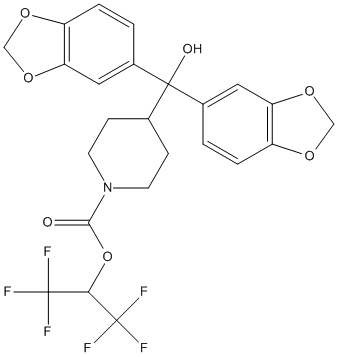KML29
Highly selective monoacylglycerol lipase (human-MGLL) inhibitor. Antinociceptive activity without cannabimimetic side effects. O-hexafluoroisopropyl analog of JZL184. Substitution of the p-nitrophenyl leaving group with a hexafluoroisopropyl one. JJKK-048 (IC50 363 pM) and KML29 (IC50 3.6 nM) both were reported to be highly selective MAGL inhibitors, and their selectivity is more than 10,000-fold over FAAH
General
Type : Halo ketone,Piperidine,Benzodioxo,Carbamate,Trifluoro
Chemical_Nomenclature : 1,1,1,3,3,3-hexafluoropropan-2-yl 4-[bis(1,3-benzodioxol-5-yl)-hydroxymethyl]piperidine-1-carboxylate
Canonical SMILES : C1CN(CCC1C(C2=CC3=C(C=C2)OCO3)(C4=CC5=C(C=C4)OCO5)O)C(=O)OC(C(F)(F)F)C(F)(F)F
InChI : InChI=1S\/C24H21F6NO7\/c25-23(26,27)20(24(28,29)30)38-21(32)31-7-5-13(6-8-31)22(33,14-1-3-16-18(9-14)36-11-34-16)15-2-4-17-19(10-15)37-12-35-17\/h1-4,9-10,13,20,33H,5-8,11-12H2
InChIKey : SXHQLPHDBLTFPM-UHFFFAOYSA-N
Other name(s) : KML 29,KML-29,SCHEMBL15100615,IN2183
MW : 549.41
Formula : C24H21F6NO7
CAS_number : 1380424-42-9
PubChem : 71656212
UniChem : SXHQLPHDBLTFPM-UHFFFAOYSA-N
IUPHAR :
Wikipedia :

Target
Families : KML29 ligand of proteins in family: Monoglyceridelipase_lysophospholip || Plasmodium_subtelomeric_PST-A
Stucture :
Protein : human-MGLL || plafa-PF10.0379
References (8)
| Title : Neuroprotective effects of minocycline and KML29, a potent inhibitor of monoacylglycerol lipase, in an experimental stroke model: a small-animal positron emission tomography study - Yamasaki_2021_Theranostics_11_9492 |
| Author(s) : Yamasaki T , Hatori A , Zhang Y , Mori W , Kurihara Y , Ogawa M , Wakizaka H , Rong J , Wang L , Liang S , Zhang MR |
| Ref : Theranostics , 11 :9492 , 2021 |
| Abstract : Yamasaki_2021_Theranostics_11_9492 |
| ESTHER : Yamasaki_2021_Theranostics_11_9492 |
| PubMedSearch : Yamasaki_2021_Theranostics_11_9492 |
| PubMedID: 34646382 |
| Title : The Endocannabinoid System Alleviates Pain in a Murine Model of Cancer-Induced Bone Pain - Thompson_2020_J.Pharmacol.Exp.Ther_373_230 |
| Author(s) : Thompson AL , Grenald SA , Ciccone HA , BassiriRad N , Niphakis MJ , Cravatt BF , Largent-Milnes TM , Vanderah TW |
| Ref : Journal of Pharmacology & Experimental Therapeutics , 373 :230 , 2020 |
| Abstract : Thompson_2020_J.Pharmacol.Exp.Ther_373_230 |
| ESTHER : Thompson_2020_J.Pharmacol.Exp.Ther_373_230 |
| PubMedSearch : Thompson_2020_J.Pharmacol.Exp.Ther_373_230 |
| PubMedID: 32054717 |
| Gene_locus related to this paper: human-MGLL |
| Title : The Antimalarial Natural Product Salinipostin A Identifies Essential alpha\/beta Serine Hydrolases Involved in Lipid Metabolism in P. falciparum Parasites - Yoo_2020_Cell.Chem.Biol_27_143 |
| Author(s) : Yoo E , Schulze CJ , Stokes BH , Onguka O , Yeo T , Mok S , Gnadig NF , Zhou Y , Kurita K , Foe IT , Terrell SM , Boucher MJ , Cieplak P , Kumpornsin K , Lee MCS , Linington RG , Long JZ , Uhlemann AC , Weerapana E , Fidock DA , Bogyo M |
| Ref : Cell Chemical Biology , 27 :143 , 2020 |
| Abstract : Yoo_2020_Cell.Chem.Biol_27_143 |
| ESTHER : Yoo_2020_Cell.Chem.Biol_27_143 |
| PubMedSearch : Yoo_2020_Cell.Chem.Biol_27_143 |
| PubMedID: 31978322 |
| Gene_locus related to this paper: plaf7-q8ii19 , plafa-a0a143zya4 , plaf7-q8iik5 , plafa-MAL8P1.38 , plafa-PF07.0040 , plafa-PF10.0020 , plafa-PF10.0379 , plafa-PF13.0153 |
| Title : Comparative biochemical characterization of the monoacylglycerol lipase inhibitor KML29 in brain, spinal cord, liver, spleen, fat and muscle tissue - Pasquarelli_2015_Neuropharmacol_91_148 |
| Author(s) : Pasquarelli N , Porazik C , Hanselmann J , Weydt P , Ferger B , Witting A |
| Ref : Neuropharmacology , 91 :148 , 2015 |
| Abstract : Pasquarelli_2015_Neuropharmacol_91_148 |
| ESTHER : Pasquarelli_2015_Neuropharmacol_91_148 |
| PubMedSearch : Pasquarelli_2015_Neuropharmacol_91_148 |
| PubMedID: 25497453 |
| Title : Postnatal ethanol exposure alters levels of 2-arachidonylglycerol-metabolizing enzymes and pharmacological inhibition of monoacylglycerol lipase does not cause neurodegeneration in neonatal mice - Subbanna_2015_J.Neurochem_134_276 |
| Author(s) : Subbanna S , Psychoyos D , Xie S , Basavarajappa BS |
| Ref : Journal of Neurochemistry , 134 :276 , 2015 |
| Abstract : Subbanna_2015_J.Neurochem_134_276 |
| ESTHER : Subbanna_2015_J.Neurochem_134_276 |
| PubMedSearch : Subbanna_2015_J.Neurochem_134_276 |
| PubMedID: 25857698 |
| Title : In vivo characterization of the highly selective monoacylglycerol lipase inhibitor KML29: antinociceptive activity without cannabimimetic side effects - Ignatowska-Jankowska_2014_Br.J.Pharmacol_171_1392 |
| Author(s) : Ignatowska-Jankowska BM , Ghosh S , Crowe MS , Kinsey SG , Niphakis MJ , Abdullah RA , Tao Q , ST ON , Walentiny DM , Wiley JL , Cravatt BF , Lichtman AH |
| Ref : British Journal of Pharmacology , 171 :1392 , 2014 |
| Abstract : Ignatowska-Jankowska_2014_Br.J.Pharmacol_171_1392 |
| ESTHER : Ignatowska-Jankowska_2014_Br.J.Pharmacol_171_1392 |
| PubMedSearch : Ignatowska-Jankowska_2014_Br.J.Pharmacol_171_1392 |
| PubMedID: 23848221 |
| Gene_locus related to this paper: human-MGLL |
| Title : Proteome-wide reactivity profiling identifies diverse carbamate chemotypes tuned for serine hydrolase inhibition - Chang_2013_ACS.Chem.Biol_8_1590 |
| Author(s) : Chang JW , Cognetta AB, 3rd , Niphakis MJ , Cravatt BF |
| Ref : ACS Chemical Biology , 8 :1590 , 2013 |
| Abstract : Chang_2013_ACS.Chem.Biol_8_1590 |
| ESTHER : Chang_2013_ACS.Chem.Biol_8_1590 |
| PubMedSearch : Chang_2013_ACS.Chem.Biol_8_1590 |
| PubMedID: 23701408 |
| Title : Highly selective inhibitors of monoacylglycerol lipase bearing a reactive group that is bioisosteric with endocannabinoid substrates - Chang_2012_Chem.Biol_19_579 |
| Author(s) : Chang JW , Niphakis MJ , Lum KM , Cognetta AB, 3rd , Wang C , Matthews ML , Niessen S , Buczynski MW , Parsons LH , Cravatt BF |
| Ref : Chemical Biology , 19 :579 , 2012 |
| Abstract : Chang_2012_Chem.Biol_19_579 |
| ESTHER : Chang_2012_Chem.Biol_19_579 |
| PubMedSearch : Chang_2012_Chem.Biol_19_579 |
| PubMedID: 22542104 |
| Gene_locus related to this paper: human-MGLL |